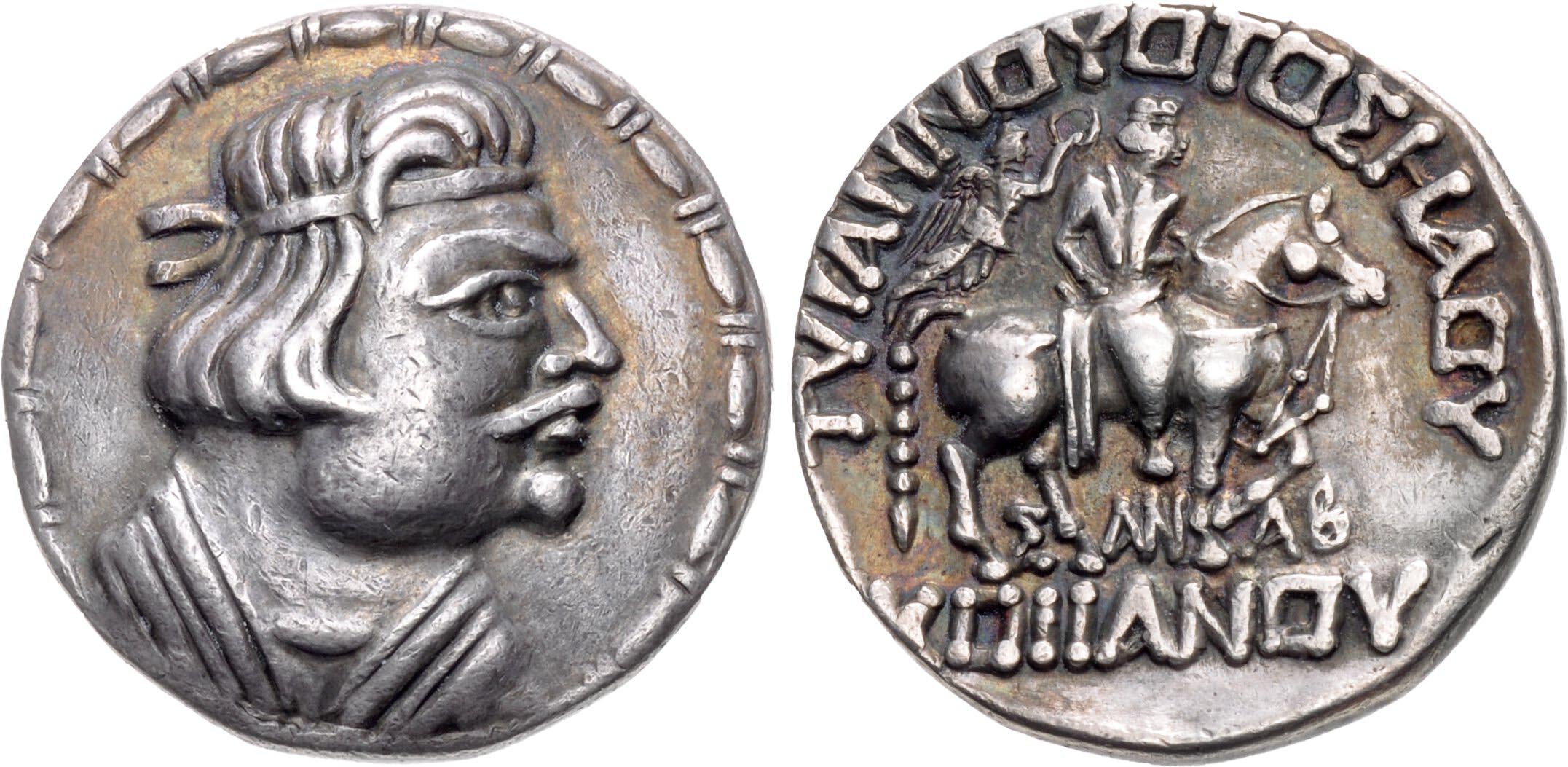S 1902 - Kushan Empire (uncertain mint) (Kujula Kadphises), silver, tetradrachms (50-90 CE)
From SILVER
50 CE - 90 CE Silver 15,981 kg
Description
| ObverseInscription or printing placed on the obverse.: | 'Heraus' type. Diademed and draped bust right |
| ReverseInscription or printing placed on the reverse.: | TYPANNOYOTOΣ HAOY KOIIANOY (Greek).Heraios on horseback right, behind, Nike flying right, crowning him with wreath, Σ AN AB below horse, quadrate Os in legends |
Mint and issuing power
| MintIdentifies the place of manufacture or issue of a numismatic object.: | Kushan Empire (uncertain mint) | Ancient regionAncient region.: | India | Modern countryModern country: India | AuthorityIdentifies the issuing power. The authority can be "pretended" when the name or the portrait of X is on the coin but he/she was not the issuing power. It can also be "uncertain" when there is no mention of X on the coin but he/she was the issuing power according to the historical sources: | Kujula Kadphises (50-90 CE), kushan empire |
Chronology
| FromIdentifies the initial date in a range assigned in a numismatic context. | 50 CE | toIdentifies the final date in a range assigned in a numismatic context.. | 90 CE | PeriodTime period of the numismatic object.: |
Physical description
| MetalThe physical material (usually metal) from which an object is made.: | Silver |
Median weightMedian of the weights of numismatic objects (in grams). in grams | 14.80 | DenominationTerm indicating the value of a numismatic object. Examples: tetradrachm, chalkous, denarius.: | tetradrachm |
StandardStandard.: |
Image

S1902 Heraios tetradrachm.jpg [1]
References
| Die study referencePublication of the study: | Cribb 19931Cribb 1993, p. 113-115 | ||
| Coin series referenceReference to coin series study: | |||
Obverse dies distribution
| FrequencyFrequency of specimen in distribution. ᵖ | Number of obversesNumber of obverse dies. ᵖ (o) | % (o) | Number of coinsNumber of coins. (n) | % (n) | Die nameName(s) of the die(s). |
| 1 | 17 | 54.84 | 17 | 29.31 | 1, 3, 4, 6, 7, 11, 15, 16, 18, 19, 22, 23, 25, 28, 29, 30, 31 |
| 2 | 7 | 22.58 | 14 | 24.14 | 5, 8, 10, 12, 14, 17, 24 |
| 3 | 4 | 12.9 | 12 | 20.69 | 2, 13, 26, 27 |
| 4 | 2 | 6.45 | 8 | 13.79 | 9, 21 |
| 7 | 1 | 3.23 | 7 | 12.07 | 20 |
| Total | 31 of 31 | 100 | 58 of 58 | 100 |
Reverse dies distribution
no distribution is available
Quantification
| Number of obversesNumber of obverse dies. ᵖ (o) | 31 | Number of singletons (o1)The number of singleton coins. ᵖ | 17 |
| Number of reverse diesNumber of reverse dies. (r) | 53 | Number of coinsNumber of coins. (n) | 58 |
| Coins per obverse dieNumber of coins per obverse die. (n/o) | 1.87 | Coins per reverse dieNumber of coins per reverse die. (n/r) | 1.09 |
| Reverse per obverse ratioRatio of obverse dies divided by reverse dies. (r/o) | 1.71 | Percentage of singletons (o1)number of coins (n) divided by the number of singletons (o1) ᵖ | 54.84 % |
| Original number of dies (O) (Carter 1983 formula)The estimation of the number of coins according to Carter 1983 ᵖ | 53.99 | Coins struck if 20,000 as average productivity per dieCoins made if the average productivity for obverses (according to Carter) is 20,000. ᵖ | 1,079,800 |
| Original number of dies (O) (Esty 2011 formula)The estimation of the number of coins according to the singleton formula in Esty 2011 ᵖ (O) | 66.59 | Survival rate if 20,000 as average productivity per dieSurvival rate if average productivity is 20,000. ᵖ | 0.00005 |
| Coverage (o = % of O) (Esty 1984 formula)Esty 1984 - coverage (% of O) ᵖ (o = % of O) | 70.69% | Die productivity if survival rate 1/2,000Average productivity if survival rate is 1/2,000. ᵖ | 2,148.55 |
| Weight of silver (in kg) if 20,000 coins per die (O = Carter formula)Carter 1983 * Median weight * 20000 (*10 if gold or electrum) ᵖ | 15,981 kg <br /> 15,981 kg | Die productivity if survival rate 1/5,000Average productivity if survival rate is 1/5,000. ᵖ | 5,371.37 |
Remarks
Most likely one single workstation
References
- ^ Cribb, Joe (1993), "The Heraus Coins: Their Attribution to the Kushan King Kujula Kadphises, c. AD 30-80," in Martin Price, Andrew Burnett, Roger Bland (eds.), Essays in honour of Robert Carson and Kenneth Jenkins, London, Spink, p. 107-134.